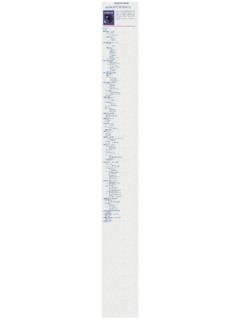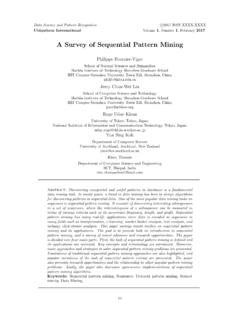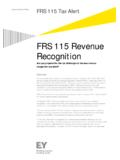Transcription of Chapter 15 Object Recognition - USF
1 Chapter 15 Object Recognition An Object Recognition system finds objects in the real world from an image of the world, using Object models which are known a priori. This task is surprisingly difficult. Humans perform Object Recognition effortlessly and instantaneously. Algorithmic description of this task for implementation on machines has been very difficult. In this Chapter we will discuss different steps in Object Recognition and introduce some techniques that have been used for Object Recognition in many applications. We will discuss the different types of Recognition tasks that a vision system may need to perform.
2 We will analyze the complexity of these tasks and present approaches useful in different phases of the Recognition task. The Object Recognition problem can be defined as a labeling problem based on models of known objects. Formally, given an image containing one or more objects of interest (and background) and a set of labels corresponding to a set of models known to the system, the system should assign correct labels to regions, or a set of regions, in the image. The Object Recognition problem is closely tied to the segmentation problem: without at least a partial Recognition of objects, segmentation cannot be done, and without segmentation, Object Recognition is not possible.
3 In this Chapter , we discuss basic aspects of Object Recognition . We present the architecture and main components of Object Recognition and discuss their role in Object Recognition systems of varying complexity. 459 460 Chapter 15. Object Recognition Image Object class Feature detector Features Hypothesis Candidate Hypothesis formation objects verification Modelbase Figure : Different components of an Object Recognition system are shown. System Component An Object Recognition system must have the following components to perform the task: Model database (also called modelbase) Feature detector Hypothesizer Hypothesis verifier A block diagram showing interactions and information flow among different components of the system is given in Figure The model database contains all the models known to the system.
4 The information in the model database depends on the approach used for the Recognition . It can vary from a qualitative or functional description to pre cise geometric surface information. In many cases, the models of objects are abstract feature vectors, as discussed later in this section. A feature is some attribute of the Object that is considered important in describing and recognizing the Object in relation to other objects. Size, color, and shape are some commonly used features. The feature detector applies operators to images and identifies locations of features that help in forming Object hypotheses.
5 The features used by a 461 SYSTEM COMPONENT system depend on the types of objects to be recognized and the organiza tion of the model database. Using the detected features in the image, the hypothesizer assigns likelihoods to objects present in the scene. This step is used to reduce the search space for the recognizer using certain features. The modelbase is organized using some type of indexing scheme to facili tate elimination of unlikely Object candidates from possible consideration. The verifier then uses Object models to verify the hypotheses and refines the likelihood of objects. The system then selects the Object with the highest likelihood, based on all the evidence, as the correct Object .
6 All Object Recognition systems use models either explicitly or implicitly and employ feature detectors based on these Object models. The hypothesis formation and verification components vary in their importance in different approaches to Object Recognition . Some systems use only hypothesis forma tion and then select the Object with highest likelihood as the correct Object . Pattern classification approaches are a good example of this approach. Many artificial intelligence systems, on the other hand, rely little on the hypothesis formation and do more work in the verification phases. In fact, one of the classical approaches, template matching, bypasses the hypothesis formation stage entirely.
7 An Object Recognition system must select appropriate tools and techniques for the steps discussed above. Many factors must be considered in the selec tion of appropriate methods for a particular application. The central issues that should be considered in designing an Object Recognition system are: Object or model representation: How should objects be represented in the model database? What are the important attributes or features of objects that must be captured in these models? For some objects, geometric descriptions may be available and may also be efficient, while for another class one may have to rely on generic or functional features.
8 The representation of an Object should capture all relevant information without any redundancies and should organize this information in a form that allows easy access by different components of the Object Recognition system. Feature extraction: Which features should be detected, and how can they be detected reliably? Most features can be computed in two dimensional images but they are related to three-dimensional charac teristics of objects. Due to the nature of the image formation process, 462 Chapter 15. Object Recognition some features are easy to compute reliably while others are very diffi cult.
9 Feature detection issues were discussed in many chapters in this book. Feature-model matching: How can features in images be matched to models in the database? In most Object Recognition tasks, there are many features and numerous objects. An exhaustive matching ap proach will solve the Recognition problem but may be too slow to be useful. Effectiveness of features and efficiency of a matching technique must be considered in developing a matching approach. Hypotheses formation: How can a set of likely objects based on the feature matching be selected, and how can probabilities be assigned to each possible Object ?
10 The hypothesis formation step is basically a heuristic to reduce the size of the search space. This step uses knowl edge of the application domain to assign some kind of probability or confidence measure to different objects in the domain. This measure reflects the likelihood of the presence of objects based on the detected features. Object verification: How can Object models be used to select the most likely Object from the set of probable objects in a given image? The presence of each likely Object can be verified by using their models. One must examine each plausible hypothesis to verify the presence of the Object or ignore it.









